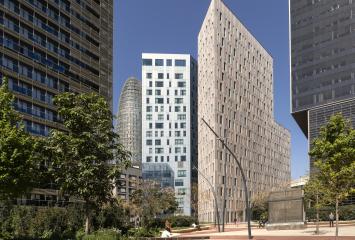Roofs Made from Plastic Bottles and Other Examples of Recycled Building Materials
The demand for new buildings will not slow down. On one hand, the global population continues to grow, meaning more people—and thus, more housing, more offices, and more public buildings. On the other hand, many existing buildings become outdated and need to be replaced. In this context, society as a whole bears the responsibility to make the building process as sustainable as possible, which involves, among other things, converting recycled materials into new building materials. This reduces environmental impact and promotes a circular economy by repurposing resources that were otherwise destined to become waste. Projects like Colonial’s buildings are a clear reflection of this shift toward a more responsible future.
Roofs Made from Plastic Bottles
Plastic bottles are one of the world’s most common and problematic waste products due to their durability and the challenges they present for full recycling. Transforming them into raw materials for creating new construction materials is thus an intriguing solution. The Bottle House, located near Abuja, Nigeria’s capital, is an excellent example of the smart use of discarded plastic bottles: the creators filled them with sand and used them to provide a solid, insulating structure for the building. It’s also a cost-effective option for areas with limited resources.
Concrete Streets Built from Old Wind Turbines
Key components of wind turbines, such as blades and towers, are made from durable materials like concrete and steel. Logically, these materials can be repurposed for new uses. This is precisely what several construction projects in Denmark have done: they crushed components of disused wind turbines to build roads, thus avoiding both the pollution that these turbines would have caused in a landfill and the consumption of natural resources that would have been needed to create new materials.
Insulation Panels Made from Recycled Cotton
The fashion industry is one of the most polluting sectors on the planet. According to data from the Pulse of the Fashion Industry report by the Global Fashion Agenda, around 92 million tons of clothing end up in landfills each year. This is a shame, as these garments contain raw materials like cotton that can be reused for other purposes. The company Bonded Logic, for instance, repurposes them to create insulation panels for buildings, helping prevent temperature and sound transfer from the inside to the outside and vice versa. It’s also a healthier option than certain synthetic insulators.
Bricks Made from Construction and Demolition Waste
Both the construction and demolition of buildings generate a significant amount of bulky, difficult-to-manage waste known as construction and demolition debris (C&D). But what if we could reuse it to make new bricks for future buildings? We can. The Indian company Terracast, for example, is deeply committed to new sustainable building methods, much like Colonial. Beyond reducing the amount of waste that ends up in natural areas and landfills, this practice prevents the extraction of new stones and clay. It’s a double win.
Recycled Glass in Modern Construction
Glass is another essential material that can be given a second life in construction. The Window Building, one of Colonial’s most iconic projects, has embraced the use of recycled glass, integrating it innovatively into its architectural design. This approach not only reduces environmental impact but also adds a unique aesthetic value to modern structures.
Beams Made from Plastic and Wood Waste
Wood is an extraordinary natural material with high insulation properties, great durability, aesthetic appeal, and a positive effect on the mood of those around it. However, it may not be sufficient to create beams for large buildings on its own. Through combining wood with other waste materials, such as plastics, recycled woods can yield beams that are far more resistant to moisture, pests, and structural stress. Brands like Trex have long been working with these composite materials. In a similar vein, Colonial developed Wittywood, a building constructed mainly from recycled wood, which demonstrates how these materials can meet the needs of modern buildings without compromising efficiency or sustainability. A new shield against environmental degradation

